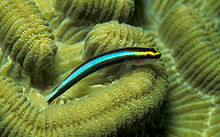- Elacatinus
-
Elacatinus 
Elacatinus evelynae Scientific classification Kingdom: Animalia Phylum: Chordata Class: Perciformes Order: Perciformes Family: Gobiidae Subfamily: Gobiinae Genus: Elacatinus
Jordan, 1904Species see text
Elacatinus (formerly Gobiosoma) is a genus of marine gobies, often known collectively as the neon gobies. Although only one species, E. oceanops, is technically the "neon goby," because of their extremely similar appearance other members of the genus are generally labeled neon gobies as well.
Contents
Description
Neon gobies are very small, torpedo-shaped fish. Although sizes vary slightly by species, they are generally about 2.5 cm (1 inch) long.[1] They have dark bodies with iridescent stripes (the color of which varies by species) running from the tip of the nose to the base of the caudal fin. Like all gobies, their dorsal fin is split in two, the anterior dorsal fin being rounded like that of a clownfish and the posterior dorsal fin being relatively flat. The anal fin lines up with the posterior dorsal fin and is of similar shape. The pectoral fins are nearly circular, and, like all other fins, transparent.
Ecology
Neon gobies are native to the tropical reefs of the Gulf of Mexico, from Texas to Belize,[2] where they live primarily in the rocks. They are well-documented cleaner fish, setting up stations where often much larger fish (sometimes even fish who would normally eat the gobies) come to have the gobies eat their small external parasites.[3] This is an excellent example of mutualism – the cleaned fish are healthier and the gobies have not only an excellent food source but also relative protection from potential predators.
In the aquarium
Members of the genus Elacatinus, particularly E. oceanops, are among the most popular marine aquarium inhabitants.
Several species of neon goby are readily available because of successful captive breeding programs, although scientific names are not always given. Generally, if the specimen has a blue stripe, it can be identified as E. oceanops, and if the stripe is half-blue half-gold, as E. evelynae. Various species are offered as "Gold Neon Gobies".
Neon gobies are not difficult to keep, and accept a wide variety of water parameters. Specific gravity is not critical, so long as it remains steady. As with all marine aquarium fish, they are sensitive to even trace amounts of ammonia or nitrite in an aquarium. Small amounts of nitrate are acceptable, but if over the long term these amounts increase this can cause problems. Neon gobies are tolerant of a broad range of temperatures, but they are tropical so a heater may be necessary to maintain a temperature of at least 25°C (78°F) year round. Other parameters, such as alkalinity only become a problem if they are extreme.
Because of their small size, neon gobies are excellent Nano Reef inhabitants, and can live in tanks as small as five gallons, but a ten gallon or larger tank is more appropriate for best health (and ease of care). In larger tanks they can be kept in groups. Neon gobies are suitable for all types of marine aquariums, with the exception of those which contain large predatory fish or invertebrates which might attempt to eat the gobies. They need plenty of hiding places, and they make excellent reef inhabitants. They are not picky eaters, and will accept any and all frozen or live foods. They can also be easily trained to take flake or pellet foods, but a variety of frozen, freeze dried, and live foods to supplement a prepared staple is the best feeding routine. They are sometimes shy eaters and may be out-competed for food by more boisterous and aggressive feeders.
If kept in pristine conditions and fed well neon gobies will readily spawn in home aquaria. A species or breeding tank is required, as the fry are small and will be eaten by most other fish. The gobies are sexually dimorphic, but the difference is not easy to ascertain so they are normally kept in large groups to ensure a balance of sexes. They will lay their eggs on any hard surface along the bottom, and the fry, which feed on small rotifers or other microscopic organisms, are fully developed within a month. The average lifespan for a neon goby is approximately a year to a year and a half.[4]
Species
- Elacatinus atronasus (Böhlke and Robins, 1968)
- Elacatinus chancei (Beebe and Hollister, 1933)
- Elacatinus digueti (Pellegrin, 1901) -- banded cleaning goby, gobio barbero, redhead goby
- Elacatinus evelynae (Böhlke and Robins, 1968) -- gobio hocicudo, gobio tiburoncito, sharknose goby, sharpnose goby
- Elacatinus figaro Sazima, Moura and Rosa, 1997
- Elacatinus genie (Böhlke and Robins, 1968) -- cleaner goby, cleaning goby, gobio limpiador
- Elacatinus horsti (Metzelaar, 1922) -- gobio de banda amarilla, yellowline goby
- Elacatinus illecebrosus (Böhlke and Robins, 1968) -- barsnout goby, gobio seductor
- Elacatinus janssi Bussing, 1981—gobio lomopintado, spotback goby
- Elacatinus jarocho (Taylor & Akins, 2007)
- Elacatinus limbaughi Hoese and Reader, 2001—gobio insólito, widebanded cleaning goby
- Elacatinus lori (Colin, 2002)
- Elacatinus louisae (Böhlke and Robins, 1968) -- gobio farol, spotlight goby
- Elacatinus macrodon (Beebe and Tee-Van, 1928) -- gobio tigre, tiger goby
- Elacatinus multifasciatus (Steindachner, 1876) -- gobio rayado, greenband goby, greenbanded goby
- Elacatinus nesiotes Bussing, 1990
- Elacatinus oceanops Jordan, 1904—neon goby
- Elacatinus pridisi (Guimarães, Gasparini & Rocha, 2004)
- Elacatinus prochilos (Böhlke and Robins, 1968) -- broadstripe goby, gobio bordeado
- Elacatinus randalli (Böhlke and Robins, 1968)
- Elacatinus saucrus (Robins, 1960) -- gobio severo, leopard goby
- Elacatinus tenox (Böhlke and Robins, 1968)
- Elacatinus xanthiprora (Böhlke and Robins, 1968) -- yellowprow goby
- Elacatinus zebrellus (Robins, 1958)
See also
References
- ^ E. oceanops, Fishbase. http://www.fishbase.org/Summary/SpeciesSummary.php?id=3876
- ^ Elacatinus Range, Fishbase. http://www.fishbase.org/Country/CountryList.cfm?ID=3876&GenusName=Elacatinus&SpeciesName=oceanops
- ^ Neon Goby Cleaner Fish Behavior. http://www.peteducation.com/article.cfm?cls=0&cat=1968&articleid=2715
- ^ Fenner, Robert M. The Conscientious Marine Aquarist. Neptune City, NJ, USA: T.F.H. Publications, 2001.
External links
Categories:- Gobiinae
- Elacatinus
Wikimedia Foundation. 2010.
















